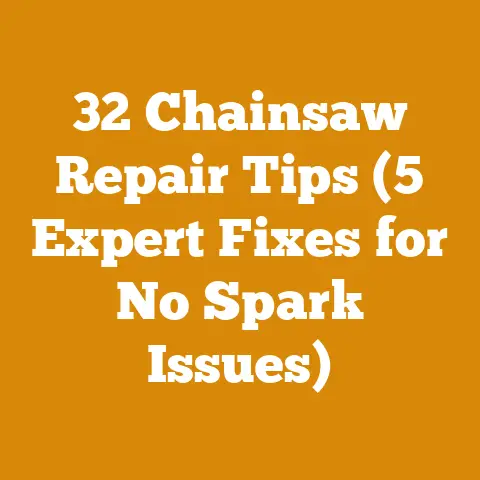30 Ton Log Splitter with Honda Engine (Engine Swap DIY Guide)
Let’s dive in!
Maximizing Resale Value: Why a Honda Engine Matters in Your 30-Ton Log Splitter
Before we even think about swapping an engine, let’s talk about something near and dear to most of our hearts: resale value. I’ve seen it time and again – a well-maintained log splitter with a reliable engine fetches a significantly higher price on the used market. Why? Because nobody wants to buy a headache.
Think about it: a potential buyer is already looking at a used piece of equipment. They’re likely trying to save money compared to buying new. But they also want reliability. A Honda engine, known for its durability and ease of maintenance, instantly inspires confidence. It’s a brand name that resonates with quality, and that translates directly into dollars when you decide to sell. So, whether you’re swapping an engine for performance, longevity, or simply because the old one gave up the ghost, consider it an investment in the future value of your log splitter.
Now, let’s get into the nitty-gritty of why you might be considering an engine swap on your 30-ton log splitter and how to tackle it the right way.
The Allure of the 30-Ton Log Splitter: Power and Efficiency
A 30-ton log splitter is a beast. It’s the kind of machine that makes short work of even the most gnarly, knotty hardwoods. But that raw power needs a reliable engine to back it up. That’s where a Honda engine comes into play. It’s like pairing a champion weightlifter with a world-class coach – the potential is already there, but the right support takes it to the next level.
Why 30 Tons? Understanding Splitting Force
The “30-ton” rating refers to the maximum force the hydraulic cylinder can exert. This force is crucial for splitting dense hardwoods like oak, maple, and hickory. The higher the tonnage, the larger and more difficult logs the splitter can handle. But it’s not just about raw power; it’s about efficiency. A 30-ton splitter, properly maintained, will split logs faster and with less strain on the machine (and you!) compared to a smaller model struggling with oversized wood.
In my experience, a 30-ton splitter is the sweet spot for most homeowners who burn a significant amount of firewood annually or those who regularly process large, tough logs. It’s powerful enough to handle almost anything you throw at it, yet still manageable in terms of size and storage.
Data Point: Splitting Force vs. Wood Density
Here’s a quick data point to illustrate the relationship between splitting force and wood density:
- Softwoods (Pine, Fir): 10-15 tons of splitting force is generally sufficient.
- Medium Hardwoods (Cherry, Ash): 20-25 tons is a good range.
- Hardwoods (Oak, Maple, Hickory): 25-30+ tons is recommended for larger, tougher logs.
This is a general guideline, of course. The actual force required will depend on the diameter, knot content, and moisture content of the wood.
Why Swap the Engine? Assessing Your Needs
So, you’re considering an engine swap. Let’s be honest, it’s not a decision most people take lightly. It’s a project that requires time, effort, and a decent amount of mechanical aptitude. So, why bother? Here are some common reasons:
- Engine Failure: This is the most obvious reason. If your original engine is beyond repair, swapping it out is often more cost-effective than buying a new log splitter.
- Performance Upgrade: Maybe you’re not satisfied with the performance of your current engine. Perhaps it’s underpowered, unreliable, or simply doesn’t start easily in cold weather. A Honda engine, known for its reliability and performance, can be a significant upgrade.
- Longevity Concerns: Some original equipment engines are simply not built to last. Swapping it out with a more robust Honda engine can significantly extend the lifespan of your log splitter.
- Maintenance Headaches: Dealing with a finicky engine can be incredibly frustrating. A Honda engine typically requires less maintenance and is easier to troubleshoot.
- Resale Value (as discussed earlier): A log splitter with a Honda engine is simply more desirable on the used market.
My Personal Experience: The Case of the Stubborn Engine
I once had a log splitter with an engine that seemed to have a personal vendetta against me. It was a constant battle to get it started, especially in the winter. I tried everything – new spark plugs, fresh fuel, carburetor cleaning – you name it. Eventually, I realized I was spending more time tinkering with the engine than actually splitting wood. That’s when I decided to bite the bullet and swap it out with a Honda. The difference was night and day. The Honda started on the first pull every time, ran smoothly, and required minimal maintenance. It was one of the best decisions I ever made.
Choosing the Right Honda Engine: A Detailed Guide
Okay, so you’re convinced that a Honda engine swap is the right move. The next step is choosing the right engine for your 30-ton log splitter. This is a crucial decision, as the engine needs to be powerful enough to drive the hydraulic pump effectively.
Key Considerations
- Horsepower (HP): This is the most important factor. A 30-ton log splitter typically requires an engine with at least 9-13 horsepower. More horsepower will result in faster cycle times (the time it takes to split a log and return the ram to the starting position).
- Shaft Size and Type: The engine’s output shaft needs to match the input shaft of your hydraulic pump. Common shaft sizes include 1″ and 1-1/8″. The shaft type (e.g., keyed, threaded) also needs to be compatible.
- Engine Mounting Pattern: The engine’s mounting holes need to align with the mounting plate on your log splitter.
- Fuel Tank Capacity: A larger fuel tank will allow you to split wood for longer periods without refueling.
- Starting Method: Honda engines are available with both recoil (pull-start) and electric start. Electric start is more convenient, but it adds to the cost and complexity.
- Emissions Standards: Ensure the engine meets the emissions standards for your area.
- Price: Honda engines vary in price depending on their horsepower, features, and emissions compliance.
Popular Honda Engine Options for Log Splitters
Here are a few popular Honda engine models that are commonly used in log splitter applications:
- Honda GX270 (9.0 HP): A reliable and versatile engine that’s a good choice for smaller 30-ton splitters or those who prioritize fuel efficiency.
- Honda GX390 (13.0 HP): A more powerful engine that’s ideal for larger 30-ton splitters or those who want faster cycle times.
- Honda GP200 (6.5 HP): Although slightly underpowered for a full 30-ton splitter, this engine is a budget-friendly option for lighter-duty applications or smaller splitters. It might be acceptable if you primarily split softer woods.
- Honda GX200 (6.5 HP): Same as above
Data Point: Horsepower and Cycle Time
Here’s some data illustrating the relationship between horsepower and cycle time:
- 9 HP Engine: Typical cycle time for a 30-ton splitter: 15-20 seconds.
- 13 HP Engine: Typical cycle time for a 30-ton splitter: 10-15 seconds.
Keep in mind that these are just estimates. The actual cycle time will depend on the specific log splitter model and the size and type of wood being split.
My Personal Recommendation
If you’re upgrading your engine or simply want the best possible performance, I recommend the Honda GX390 (13.0 HP). It’s a powerful, reliable, and relatively affordable engine that will make your 30-ton log splitter a true workhorse.
Gathering Your Tools and Materials: Preparation is Key
Before you start tearing into your log splitter, it’s essential to gather all the necessary tools and materials. This will save you time and frustration in the long run.
Essential Tools
- Socket Set: Metric or SAE, depending on your log splitter.
- Wrench Set: Same as above.
- Screwdrivers: Both Phillips head and flathead.
- Pliers: Regular pliers, needle-nose pliers, and possibly vise-grips.
- Hammer: For persuasion, if needed.
- Engine Hoist or Jack: To lift the old engine out and the new engine in.
- Torque Wrench: To tighten bolts to the proper specifications.
- Multimeter: To check electrical connections.
- Fuel Line Disconnect Tool: If your log splitter has quick-disconnect fuel lines.
- Oil Drain Pan: To catch the old engine oil.
- Rags: Lots of rags for cleaning up spills.
- Safety Glasses: To protect your eyes.
- Gloves: To protect your hands.
Essential Materials
- New Honda Engine: The heart of the project.
- Engine Oil: Use the type and weight recommended by Honda.
- Fuel: Fresh gasoline.
- Threadlocker (Loctite): To prevent bolts from loosening.
- Electrical Tape: To insulate electrical connections.
- Zip Ties: To secure wiring.
- New Fuel Line (if needed): Replace the fuel line if it’s cracked or deteriorated.
- New Fuel Filter (if needed): A clean fuel filter will help protect the engine.
- New Spark Plug (optional): A fresh spark plug is always a good idea.
- Engine Mounting Bolts (if needed): The new engine may require different mounting bolts than the old engine.
- Wiring Connectors (if needed): To connect the engine’s wiring to the log splitter’s wiring.
- Shop Manual: For your log splitter and the new Honda engine. These manuals contain valuable information about disassembly, assembly, and troubleshooting.
My Personal Tip: Take Pictures!
Before you start disconnecting anything, take plenty of pictures. This will help you remember how everything goes back together. Trust me, you’ll thank yourself later.
Step-by-Step Engine Swap Guide: A Detailed Walkthrough
Okay, let’s get down to business. Here’s a detailed step-by-step guide to swapping the engine on your 30-ton log splitter.
Important Safety Note: Disconnect the spark plug wire from the old engine before you start working on it. This will prevent accidental starting.
Step 1: Disconnect the Fuel Line
- Locate the fuel line that connects the fuel tank to the engine.
- If your log splitter has quick-disconnect fuel lines, use a fuel line disconnect tool to separate the fuel line.
- If your log splitter has a traditional fuel line with hose clamps, loosen the hose clamps and carefully pull the fuel line off the engine.
- Drain the fuel tank completely. This will prevent fuel spills.
Step 2: Disconnect the Wiring
- Identify all the wires that connect the engine to the log splitter. These may include wires for the kill switch, the oil sensor, and the electric start (if equipped).
- Carefully disconnect each wire. Use a multimeter to check the voltage and continuity of each wire before disconnecting it. This will help you troubleshoot any electrical problems later on.
- Label each wire with masking tape and a marker. This will help you reconnect the wires correctly.
Step 3: Disconnect the Throttle Cable
- Locate the throttle cable that connects the throttle lever to the engine.
- Loosen the set screw or nut that secures the throttle cable to the engine’s throttle linkage.
- Carefully disconnect the throttle cable from the engine.
Step 4: Disconnect the Hydraulic Pump (if necessary)
- In some cases, you may need to disconnect the hydraulic pump from the engine before you can remove the engine. This is especially true if the engine and pump are mounted close together.
- If necessary, disconnect the hydraulic lines from the pump. Be sure to relieve the pressure in the hydraulic system before disconnecting the lines.
- Carefully disconnect the pump from the engine.
Step 5: Remove the Engine Mounting Bolts
- Locate the bolts that secure the engine to the log splitter’s mounting plate.
- Use a socket wrench to remove the bolts.
- Save the bolts. You may need them to mount the new engine.
Step 6: Remove the Old Engine
- Use an engine hoist or jack to lift the old engine off the log splitter.
- Be careful not to damage the log splitter’s frame or hydraulic pump.
- Dispose of the old engine properly.
Step 7: Prepare the Mounting Plate
- Clean the mounting plate thoroughly.
- Remove any rust or corrosion.
- Inspect the mounting plate for cracks or damage. Repair or replace the mounting plate if necessary.
Step 8: Install the New Engine
- Use an engine hoist or jack to lift the new engine onto the mounting plate.
- Align the engine’s mounting holes with the holes in the mounting plate.
- Install the engine mounting bolts.
- Tighten the bolts to the proper torque specifications.
Step 9: Reconnect the Hydraulic Pump (if necessary)
- If you disconnected the hydraulic pump from the engine, reconnect it now.
- Be sure to align the pump correctly.
- Tighten the hydraulic lines securely.
Step 10: Reconnect the Throttle Cable
- Reconnect the throttle cable to the engine’s throttle linkage.
- Adjust the throttle cable so that the engine idles properly and reaches full throttle.
Step 11: Reconnect the Wiring
- Reconnect all the wires that you disconnected earlier.
- Use the labels that you created to ensure that you reconnect the wires correctly.
- Use electrical tape to insulate any exposed wires.
Step 12: Reconnect the Fuel Line
- Reconnect the fuel line to the engine.
- Make sure the fuel line is securely attached.
Step 13: Add Engine Oil and Fuel
- Add engine oil to the engine. Use the type and weight recommended by Honda.
- Add fuel to the fuel tank.
Step 14: Start the Engine
- Turn on the fuel valve.
- Set the choke to the “on” position.
- Pull the starter rope or turn the key to start the engine.
- Let the engine warm up for a few minutes.
Step 15: Test the Log Splitter
- Test the log splitter to make sure it’s working properly.
- Check for leaks.
- Adjust the throttle cable and hydraulic pressure as needed.
My Personal Caveat: Don’t Skip the Shop Manual!
I cannot stress this enough: Consult the shop manual for your log splitter and the new Honda engine. These manuals contain valuable information about disassembly, assembly, and troubleshooting. Skipping this step could lead to serious problems.
Troubleshooting Common Issues: When Things Go Wrong
Even with the best planning and preparation, things can sometimes go wrong during an engine swap. Here are some common issues and how to troubleshoot them:
- Engine Won’t Start:
- Check the fuel supply. Make sure there’s fuel in the tank and that the fuel valve is open.
- Check the spark plug. Make sure the spark plug is clean and properly gapped.
- Check the ignition system. Make sure the spark plug wire is securely attached to the spark plug.
- Check the compression. If the engine has low compression, it may need to be rebuilt.
- Engine Runs Rough:
- Check the air filter. A dirty air filter can restrict airflow and cause the engine to run rough.
- Check the carburetor. A dirty or clogged carburetor can also cause the engine to run rough.
- Check the spark plug. A fouled spark plug can cause the engine to misfire.
- Log Splitter Doesn’t Split Logs:
- Check the hydraulic fluid level. If the hydraulic fluid level is low, the log splitter won’t be able to generate enough pressure to split logs.
- Check the hydraulic pump. A damaged or worn hydraulic pump may not be able to generate enough pressure.
- Check the hydraulic cylinder. A leaking hydraulic cylinder can also cause a loss of pressure.
- Leaks:
- Check all the fuel lines and hydraulic lines for leaks.
- Tighten any loose connections.
- Replace any damaged or worn lines.
My Personal Tip: Don’t Be Afraid to Ask for Help!
If you’re stuck, don’t be afraid to ask for help. There are plenty of online forums and communities where you can get advice from experienced mechanics. You can also take your log splitter to a local repair shop.
Maintaining Your Honda Engine: Ensuring Long-Term Performance
Once you’ve successfully swapped the engine on your log splitter, it’s important to maintain the engine properly to ensure long-term performance.
Regular Maintenance Tasks
- Check the Engine Oil Level: Check the engine oil level before each use. Add oil as needed to maintain the proper level.
- Change the Engine Oil: Change the engine oil every 50-100 hours of use, or at least once a year.
- Clean the Air Filter: Clean the air filter every 25 hours of use, or more often in dusty conditions.
- Replace the Spark Plug: Replace the spark plug every 100 hours of use, or at least once a year.
- Check the Fuel Filter: Check the fuel filter periodically and replace it if it’s clogged.
- Inspect the Fuel Lines: Inspect the fuel lines for cracks or leaks. Replace the fuel lines if necessary.
- Store the Log Splitter Properly: Store the log splitter in a dry place when not in use. Drain the fuel tank before storing the log splitter for extended periods.
Data Point: The Cost of Neglect
Neglecting regular engine maintenance can lead to serious problems and costly repairs. For example, running an engine with low oil can cause severe damage to the engine’s internal components, potentially requiring a complete engine rebuild.
My Personal Habit: The Annual Checkup
I make it a habit to give my log splitter a thorough checkup at the end of each splitting season. I change the oil, clean the air filter, replace the spark plug, and inspect all the fuel lines and hydraulic lines. This helps me ensure that the log splitter is ready to go when I need it next season.
Wood Science and Firewood Preparation: Beyond the Split
Swapping the engine is a big step, but let’s not forget the bigger picture: efficiently and safely processing firewood. Understanding wood science and employing proper firewood preparation techniques are just as crucial as having a powerful log splitter.
Wood Anatomy and Properties
- Hardwood vs. Softwood: Hardwoods, like oak and maple, are denser and burn longer than softwoods, like pine and fir. However, softwoods ignite more easily and are good for starting fires.
- Moisture Content: Green wood (freshly cut) has a high moisture content (50% or more). Burning green wood is inefficient, produces a lot of smoke, and can damage your chimney. Seasoned wood (dried for 6-12 months) has a moisture content of 20% or less and burns much more efficiently.
- Density and BTU Value: The higher the density of the wood, the higher its BTU (British Thermal Unit) value. BTU is a measure of the amount of heat released when the wood is burned.
Firewood Seasoning Techniques
- Splitting: Splitting wood increases its surface area, allowing it to dry more quickly.
- Stacking: Stack the wood in a single row, off the ground, with plenty of space for air circulation.
- Location: Choose a sunny, windy location for your woodpile.
- Covering: Cover the top of the woodpile to protect it from rain and snow, but leave the sides open for air circulation.
Data Point: Moisture Content and Heat Output
Here’s some data illustrating the relationship between moisture content and heat output:
- Green Wood (50% Moisture): Produces approximately 4,000 BTU per pound.
- Seasoned Wood (20% Moisture): Produces approximately 7,000 BTU per pound.
As you can see, seasoned wood produces significantly more heat than green wood.
My Personal Method: The Two-Year Plan
I like to maintain a two-year supply of firewood. This allows me to ensure that all my wood is properly seasoned before I burn it. I split and stack a new batch of wood each year, and I burn the wood that I split the previous year. This system works well for me and ensures that I always have a supply of dry, efficient firewood.
Logging Tool Selection and Maintenance: Working Safely and Effectively
While the log splitter does the heavy lifting, other logging tools are essential for safely and efficiently processing wood.
I never compromise on safety, and I always make sure that I’m wearing the appropriate safety gear and using the right tools for the job. I also make sure that I’m working in a safe environment and that I’m not taking any unnecessary risks.
Project Planning and Execution: A Strategic Approach
Engine swapping, firewood preparation, and logging are all projects that require careful planning and execution. A strategic approach can help you save time, money, and frustration.
Project Planning Steps
- Define Your Goals: What do you want to achieve with this project?
- Assess Your Resources: What tools, materials, and skills do you have available?
- Develop a Plan: Outline the steps you need to take to complete the project.
- Set a Budget: Estimate the cost of the project and set a budget.
- Create a Timeline: Estimate how long the project will take and create a timeline.
Project Execution Tips
- Start Small: Break the project down into smaller, manageable tasks.
- Stay Organized: Keep your tools and materials organized.
- Follow Your Plan: Stick to your plan as closely as possible.
- Be Flexible: Be prepared to adjust your plan if necessary.
- Take Breaks: Take breaks to avoid fatigue.
- Celebrate Your Successes: Acknowledge and celebrate your accomplishments along the way.
My Personal Strategy: The Checklist
I’m a big fan of checklists. I use checklists to plan and execute all my projects, from engine swapping to firewood preparation. A checklist helps me stay organized, ensures that I don’t forget any important steps, and allows me to track my progress.
Conclusion: Embracing the Power and Responsibility
Swapping a Honda engine onto your 30-ton log splitter is a significant undertaking, but it can be a rewarding one. Not only will you improve the performance and reliability of your log splitter, but you’ll also increase its resale value. But remember, the engine swap is just one piece of the puzzle. Understanding wood science, employing proper firewood preparation techniques, and using logging tools safely and effectively are all essential for successfully processing wood.
By following the steps outlined in this guide, you can confidently tackle an engine swap and transform your log splitter into a true wood-splitting machine. And by embracing a strategic approach to project planning and execution, you can ensure that all your wood processing endeavors are successful and rewarding. Now, get out there and split some wood!






